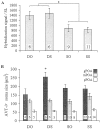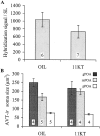Social influences on the arginine vasotocin system are independent of gonads in a sex-changing fish
- PMID: 12764128
- PMCID: PMC6741075
- DOI: 10.1523/JNEUROSCI.23-10-04386.2003
Social influences on the arginine vasotocin system are independent of gonads in a sex-changing fish
Abstract
Many neuropeptide systems subserving sex-typical behavior are dependent on sex steroids for both their organization early in life and activation during maturity. The arginine vasopressin/vasotocin (AVP/AVT) system is strongly androgen dependent in many species and critically mediates responses to sociosexual stimuli. The bluehead wrasse is a teleost fish that exhibits a female-to-male sex change in response to social cues, and neither the development nor the maintenance of male-typical behavior depends on the presence of gonads. To examine social and gonadal inputs on the AVP/AVT system in the preoptic area (POA) of the hypothalamus, we conducted three field experiments. In the first experiment, we found that AVT mRNA abundance is higher in sex-changing females that attain social dominance and display dominant male behavior than in subordinate females, regardless of whether the dominant females were intact or ovariectomized. However, AVT-immunoreactive (IR) soma size in the gigantocellular POA (gPOA), but not in the magnocellular or parvocellular POA, increased only when females were displaying both dominant male behavior and had developed testes. In the second experiment, castration of dominant terminal-phase males had no effect on AVT mRNA abundance or any behavior we measured but did increase gPOA AVT-IR soma size compared with sham-operated controls. In the third experiment, 11-ketotestosterone implants in socially subordinate, ovariectomized females had no effect on either AVT mRNA abundance or AVT-IR soma size compared with controls. These results demonstrate that the AVT neural phenotype in the bluehead wrasse can be strongly influenced by social status, and that these social influences can be manifested independent of gonads.
Figures




Similar articles
-
Hypothalamic arginine vasotocin mRNA abundance variation across sexes and with sex change in a coral reef fish.Brain Behav Evol. 2000 Feb;55(2):77-84. doi: 10.1159/000006643. Brain Behav Evol. 2000. PMID: 10838478
-
Multiple mechanisms of phenotype development in the bluehead wrasse.Horm Behav. 2004 May;45(5):345-53. doi: 10.1016/j.yhbeh.2004.01.003. Horm Behav. 2004. PMID: 15109909
-
Social Status and Arginine Vasotocin Neuronal Phenotypes in a Cichlid Fish.Brain Behav Evol. 2015;85(3):203-13. doi: 10.1159/000381251. Epub 2015 May 13. Brain Behav Evol. 2015. PMID: 25997523
-
Sex dimorphism in the avian arginine vasotocin system with special emphasis to the bed nucleus of the stria terminalis.Comp Biochem Physiol A Mol Integr Physiol. 2002 Apr;131(4):833-7. doi: 10.1016/s1095-6433(02)00021-1. Comp Biochem Physiol A Mol Integr Physiol. 2002. PMID: 11897194 Review.
-
Brain vasotocin pathways and the control of sexual behaviors in the bullfrog.Brain Res Bull. 1997;44(4):345-50. doi: 10.1016/s0361-9230(97)00213-x. Brain Res Bull. 1997. PMID: 9370198 Review.
Cited by
-
Expression of arginine vasotocin in distinct preoptic regions is associated with dominant and subordinate behaviour in an African cichlid fish.Proc Biol Sci. 2008 Oct 22;275(1649):2393-402. doi: 10.1098/rspb.2008.0622. Proc Biol Sci. 2008. PMID: 18628117 Free PMC article.
-
Brain nonapeptide and gonadal steroid responses to deprivation of heterosexual contact in the black molly.Biol Open. 2014 Dec 19;4(1):69-78. doi: 10.1242/bio.20149597. Biol Open. 2014. PMID: 25527645 Free PMC article.
-
Seasonal expression of arginine vasotocin mRNA and its correlations to gonadal steroidogenic enzymes and sexually dimorphic coloration during sex reversal in the gilthead seabream (Sparus aurata).Fish Physiol Biochem. 2017 Jun;43(3):823-832. doi: 10.1007/s10695-017-0338-3. Epub 2017 Mar 18. Fish Physiol Biochem. 2017. PMID: 28315977
-
GnRH isoforms expression in relation to the gonadal cycle and to dominance rank in the gilthead seabream, Sparus aurata.Fish Physiol Biochem. 2013 Aug;39(4):993-1005. doi: 10.1007/s10695-012-9757-3. Epub 2012 Dec 18. Fish Physiol Biochem. 2013. PMID: 23248050
-
Neurohormones, Brain, and Behavior: A Comparative Approach to Understanding Rapid Neuroendocrine Action.Integr Comp Biol. 2015 Aug;55(2):264-7. doi: 10.1093/icb/icv007. Epub 2015 Apr 20. Integr Comp Biol. 2015. PMID: 25896107 Free PMC article.
References
-
- Arnold AP, Breedlove SM ( 1985) Organizational and activational effects of sex steroids on brain and behavior: a reanalysis. Horm Behav 19: 469–498. - PubMed
-
- Borg B ( 1994) Androgens in teleost fishes. Comp Biochem Physiol C Pharmacol Toxicol Endocrinol 109: 219–245.
-
- Braford Jr MR, Northcutt RG ( 1983) Organization of the diencephalon and pretectum of the ray finned fishes. In: Fish neurobiology (Davis RE, Northcutt RG, eds), pp 117–164. Ann Arbor, MI: University of Michigan.
-
- Cardwell JR, Liley NR ( 1991) Androgen control of social status in males of a wild population of stoplight parrotfish, Sparisoma viride (Scaridae). Horm Behav 25: 1–18. - PubMed
-
- Crews D, Moore MC ( 1986) Evolution of mechanisms controlling mating-behavior. Science 231: 121–125. - PubMed
Publication types
MeSH terms
Substances
Grants and funding
LinkOut - more resources
Full Text Sources
Miscellaneous
